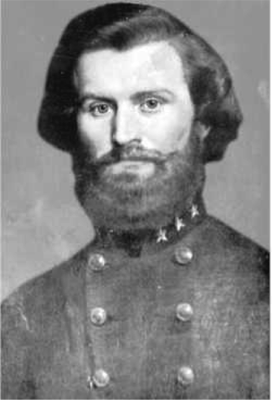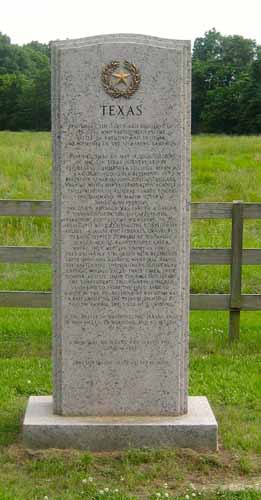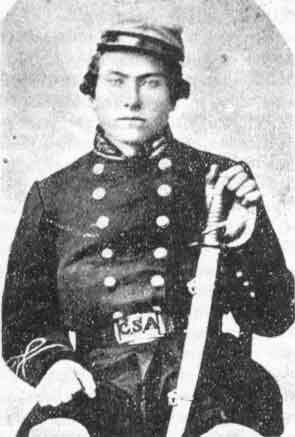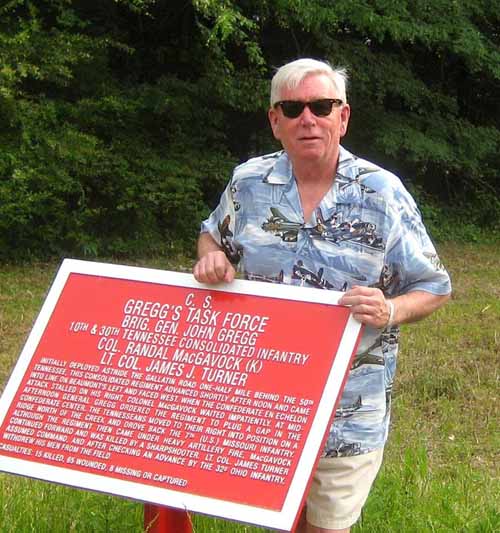
(Colonel Randall McGavock, 10th Tennessee Irish Regiment, CSA)
We walked back up the asphalt path that surrounds the core area of the battlefield at Raymond slowly. Both of us are having some mobility problems these days- I beat my knees into submission and the arthritis is painful, amplified by that damned ruptured quadriceps a couple years ago. My pal took a bad fall in an adventure on his mountain property a few years ago, and the rehabilitation has been long and not complete.
But we were both happy to be someplace where history had been made, and there were stories that were told about what had happened here. A local approached us, headed for the old disused concrete bridge over Fourteen Mile Creek.
“Howdy, all ya’ll,” he said as we passed, and we responded the same way.
“He probably knew we were Yankees,” my pal said.
“I have no doubt. But I had kin on the field, maybe on both sides. I wish I could remember what Ohio Volunteer Infantry Regiment Great Grandfather was in. I saw on the sign that the 20th Ohio was right here, in the center of the Union counter-attack.”
“Tantalizing thought, but you should be able to do the research when you get home.”
“I wish I had a copy of his service record. I held in in my hands years ago at the National Archives. I was pretty amazed that they were able to whistle it up in a half our. I wouldn’t think there would be that much call for the original records these days.”
We approached his white car in the parking area at the north end of the field. “I will show you the Texas Monument across the road. It is on private land, but the battle itself extended almost a mile in that direction, along the high ground.” He described and arc with his hand. “I trespassed the last time, but the gate was open and the owner showed me up to the signs that describe what happened up there. The Friends of Raymond had them placed there in the last few years.”
“So that is the ‘non-contiguous’ property they were talking about? Do we have to trespass to get there?”
“If the gate is open we can just ask the owner if it is OK. I am sure they will understand if you tell them the story.”
“So, I didn’t get it from Uncle Patrick’s account of the fight. I didn’t understand that the combine 10th/30th Tennessee Irish were the extreme left flank of the Confederate line.”
“Yes, the understrength 10th had been augmented with the 30th to bring up their TOE to something near combat effective. They got here on the 11th, marching from Port Hudson to Jackson, and then the twelve miles to Raymond.”
“They did a lot of marching. They must have been fit- and particularly in those woolen uniforms. I heard that Colonel Randall McGavock bought them for his men out of his own pocket- fine things. Patrick said the jackets and pants were Confederate Gray with a scarlet line running down the pant legs. The hats were gray with scarlet trim. The shirts and insides of the jackets were also scarlet. The officers got crimson and gold trimming on their jacket sleeves.”
“Not many got uniforms that fancy. General Gregg found this position to give fight, with the creek in front and the high-ground to his back. The 10th was up there,” he said pointing. We got in the car and drove back toward the modern route of Highway 18. Directly along what would have been the front lined there was a granite memorial to the right of a well-tended gravel drive with a gate that was firmly closed.
“We will have to try it from the other side,” said my pal. “I think I can find it.”

I said that I needed to get out and see the Texas monument.
“The Texans have been doing that lately for their Civil War battles. I guess it is because their economy is going pretty well.”
This one was relatively small- a little taller than me, and with a dense long inscription on the side facing the highway. The words read:
UPON THIS FIELD ON MAY 12, 1863, SOLDIERS
OF THE 7TH TEXAS INFANTRY, LED BY REGIMENTAL
COMMANDER COLONEL HIRAM B. GRANBURY, AND OTHER
REGIMENTS OF BRIGADIER GENERAL JOHN GREGG’S
BRIGADE FOUGHT WITH GRIM DETERMINATION AGAINST
TWO DIVISIONS OF FEDERAL FORCES UNDER COMMAND
OF MAJOR GENERAL JAMES B. MCPHERSON.
THE UNION ADVANCE WAS PART OF A LARGER
CAMPAIGN DESIGNED TO CAPTURE THE STRATEGIC PORT
CITY OF VICKSBURG ON THE MISSISSIPPI RIVER.
LEADING THE CONFEDERATE ASSAULT AGAINST THE
FEDERALS, GRANBURY’S TEXANS STEPPED FORWARD
AT NOON AND SURGED ACROSS FOURTEENMILE CREEK,
WHERE THEY MET THE ENEMY IN FORCE.
THEY VALIANTLY STRUGGLED WITH REGIMENTS
FROM OHIO AND ILLINOIS, WHILE ALL ALONG THE
BATTLE LINE THE SOUTHERN SOLDIERS OF GREGG’S
BRIGADE FACED THREE TIMES THEIR NUMBER.
DESPITE THEIR COURAGEOUS EFFORT, THE
CONFEDERATE TROOPS WERE CHECKED AND
FORCED FROM THE FIELD AROUND 4:30 P.M.
THE ENGAGEMENT AT RAYMOND WAS A PRECURSOR
TO THE INTENSE FIGHTING TO FOLLOW
DURING THE SIEGE OF VICKSBURG.
IN THE BATTLE OF RAYMOND, THE TEXANS LOST
22 MEN KILLED, 73 WOUNDED, AND 63 MISSING IN ACTION.
A MEMORIAL TO TEXANS WHO SERVED THE CONFEDERACY.
I had to take several pictures of the inscription to get it all in. I got back in the car and we backed up and got pointed toward the highway again.
“I am pretty sure I know how to find the plaques,” he said. “But it might be a long walk in the woods. We turned onto the highway and proceeded north to the first road that seemed to lead in the right direction and drove past some houses. We didn’t want to park in anyone’s driveway, but there was a derelict house almost completely overgrown with some fields behind, revealed by a tractor cut through the thick underbrush.
We pulled into the gravel of what had been the driveway, parked and dismounted. We walked toward the field, passing the overgrown house.
“How is it that something with a roof on it could become so worthless that they walked away?” I asked.
“Maybe it is just the farmland that has any value, or maybe it was part of the battlefield property that the Friends of Raymond bought. I don’t know.”
“Just so long as no one minds we are traipsing around their property,” I said. We walked on to the middle of the field. No markers visible. We didn’t know whether to go left or right at the tree-line, and decided that right was the best possibility. The next field was likewise barren of interpretive signage. I was starting to lose hope when my pal let out a whoop! “There it is! Come on!”
Actually, as we approached, we saw there were two of the red metal plaques set on sturdy poles and sunk in concrete.
“So this was the extreme left of the line?” I asked.
“It was until the 10th started to move in echelon back toward the creek where we were before. The plaques had additional information:
“At noon, Gregg charged with the 7th hitting the 20th Ohio and the 3rd hitting the 23 Ind. surprising and driving back the Yankees. At 1:00 p.m., the 50th and the 10th were ordered forward. Lt. Col. Beamount of the 50th then saw what Gregg had not yet seen. Two Yankee divisions were massing to attack in his front. He withdrew his regiment to the rear. This left a 400 yard gap in the line with the 10th all alone. By 1:30, the Confederate right began to collapse. McGavock’s vision was blocked by the woods and had no idea that the 50th was gone. When Gregg discovered that the 50th had disappeared, he ordered McGavock to stop the Yankees. With his sword in his hand, he turned toward his faithful Irishmen to signal to advance. With a deafening Irish-rebel yell, they surge into the oncoming Yankees. After making the signal to advance, McGavock turned to face the Yankees. At that moment, a single Yankee Minie ball struck him in the heart, knocking him to the ground, mortally wounded.”

(Patrick Griffin, in the day).
We read the words in silence. “This is where Uncle Patrick comes in, at least according to his version of the story. He said he was standing about two paces in the rear of the line and Colonel McGavock was standing about four paces behind him. They had been engaged for about twenty minutes when he heard a ball strike something. He realized it was his Colonel, wearing that red shirt of his under his gray frock coat. The Colonel was about to fall. He caught him and eased him down with his head in the shadow of a little bush. Patrick knew he was a goner, and asked if he had any message for his mother. The answer was: ‘Griffin, take care of me! Griffin, take care of me! He lived only for a few minutes. Must have been right here. Would you take a picture of me here?” I looked skyward…”Patrick!” I shouted. “It took a while, but I made it!”

We looked around the tree-line, seeing where Colonel McGavock would have led his wild Irishmen, if he had lived.
“So that was it or Patrick’s part of the war in the west. He continued to fight until the ‘Bloody Tinth’ withdrew from the field. Then he went to the Lt. Colonel who had risen to command with McGavock’s death, and told him he was going back to get McGavock’s body. He told him he had made the promise as the Colonel died and he was going to ensure he got a proper burial, whatever the consequences.”
We started the long trudge back to the car. My legs were feeling a little rubbery. “I am glad I am not carrying you on foot back to Raymond,” I said to my pal.
“And I am equally glad that I am not carrying you, my friend. Perhaps we should stop at the Confederate cemetery on the way back to town.”
“I assume that is where Randall McGavock was buried, the first time. At least that is where Patrick put him. The dead used to move around a lot more than they do these days. I looked around the green fields and the shadows from the trees that hugged the high ground.
In a strange way, I felt quite at home.
Copyright 2015 Vic Socotra
www.vicsocotra.com
Twitter: @jayare303
